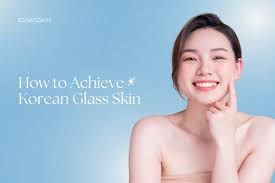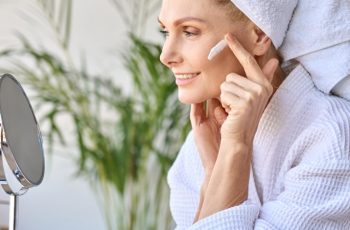
How to Get Glass Skin at Home: The Ultimate Guide to Radiant, Smooth, Glowing Skin
If you’re even remotely interested in skincare, chances are you’ve heard of the coveted glass skin trend—a Korean beauty (K-beauty) phenomenon that has captivated skincare enthusiasts worldwide. The term “glass skin” describes a complexion that’s so smooth, luminous, and clear, it reflects light like glass. Think dewy, hydrated, poreless, and radiantly healthy—without the need for heavy makeup.
Unlike fads that promise overnight results, achieving glass skin requires consistency and the right combination of hydrating, exfoliating, and brightening products that work with your skin type. In this guide, we’ll walk you through the steps, ingredients, and recommended products to help you build a glass skin routine that works—right from the comfort of your home.
What Is Glass Skin?
Glass skin isn’t just about hydration—it’s a multi-faceted skincare goal that involves a holistic approach to skin health. At its core, glass skin is:
Exceptionally smooth: No visible texture, rough patches, or congestion.
Evenly toned: A uniform skin tone with minimal pigmentation or redness.
Luminous and dewy: Skin that naturally reflects light due to optimal hydration and exfoliation.
Poreless in appearance: While no one truly has invisible pores, glass skin minimizes their visibility by keeping them clean and clear.
The result? Skin that glows from within and feels as soft as it looks.
The Science Behind the Glow: Why Exfoliation Matters
One of the most critical steps in your glass skin routine is exfoliation. Over time, the surface of our skin accumulates dead skin cells, which can dull the complexion, clog pores, and interfere with how well other products absorb.
This build-up can occur due to:
Slowed cell turnover with age
Lack of regular exfoliation
Dry skin types that shed less efficiently
Environmental stressors and pollution
✨ Why Exfoliation Is Key
Dead skin cells don’t reflect light well. They create a rough, uneven surface that scatters light instead of reflecting it, making your complexion appear tired or lackluster.
By regularly exfoliating with AHAs (Alpha Hydroxy Acids) or BHAs (Beta Hydroxy Acids), you:
Stimulate cell turnover
Smooth skin texture
Brighten your overall tone
Improve product penetration
Step-by-Step: How to Get Glass Skin at Home
Achieving glass skin is all about layering lightweight, hydrating, and refining products. Here’s a complete step-by-step routine you can follow at home.
Step 1: Gentle but Effective Cleansing
A low-pH, exfoliating cleanser sets the stage for everything that follows. These cleansers not only remove dirt, oil, and impurities but also contain hydroxy acids that loosen dead skin cells.
Top Cleanser Picks for Glass Skin
Essopi Glycolic 10% Moisturizing Cleanser
Perfect for dry skin types
Contains 10% glycolic acid, an AHA that deeply exfoliates
Infused with vitamins A, C, E, green tea extract, and CoQ10 to support collagen production
SkinCeuticals LHA Cleansing Gel
Ideal for acne-prone skin types
Contains salicylic acid (BHA) + glycolic acid + glycerin
Reduces blemishes while deeply cleansing pores
PCA Skin Facial Wash
Great for sensitive skin
Formulated with lactic acid for mild exfoliation
Contains allantoin and aloe vera for soothing benefits
SkinMedica AHA/BHA Exfoliating Cleanser
Designed for combination or oily skin
Combines AHAs, BHAs, and jojoba beads for a thorough exfoliating cleanse
Best used under dermatologist supervision due to its strength
Step 2: Exfoliate (2–3 Times Per Week)
While exfoliating cleansers are gentle enough for daily use, you’ll also want to incorporate a physical or chemical scrub a few times a week for extra smoothing power.
Top Exfoliator Picks
Pidanti Smoothing Polish Face & Body Scrub
Uses microcrystalline cellulose beads (eco-friendly and non-abrasive)
Contains glycolic acid and salicylic acid for double exfoliation
Brightens skin with arbutin and ascorbyl palmitate
Jan Marini Bioglycolic Resurfacing Scrub
Combines exfoliating granules with glycolic acid
Contains aloe and chamomile to reduce inflammation
Great for oily, acne-prone skin
ClarityRx Down + Dirty Detoxifying Charcoal MicroExfoliant
Doubles as a mask and scrub
Features activated charcoal to lift toxins and seaweed extract to nourish
Leaves skin feeling detoxed and refreshed
Step 3: Apply a Brightening Serum
Serums are the powerhouse of any skincare routine. For glass skin, choose lightweight, water-based serums that include:
Hydroxy acids (glycolic, lactic, salicylic)
Niacinamide (for tone and texture)
Vitamin C (for antioxidant protection and glow)
Recommended Glass Skin Serums
SkinCeuticals LHA Serum
Contains lipo-hydroxy acid (LHA) and glycolic acid
Refines texture and smooths skin
Fast-absorbing and non-greasy
ClarityRx Brighten It Lactic Acid Serum
Features 10% lactic acid
Moisturizes while exfoliating—perfect for all skin types
Promotes even tone and refined texture
Step 4: Hydrate and Moisturize
Hydration is a non-negotiable step in the glass skin routine. Hydrated skin plumps up, reflects light better, and minimizes the appearance of pores and fine lines.
Look for moisturizers with:
Hyaluronic acid
Ceramides
Squalane
Glycerin
Pair your moisturizer with a facial mist for an extra burst of hydration throughout the day.
Step 5: Seal It with SPF (Morning Only)
No glass skin routine is complete without daily sun protection. UV rays are the top cause of premature aging and pigmentation, and without SPF, all your efforts to exfoliate and brighten could be undone.
Use a broad-spectrum SPF 30 or higher that is:
Lightweight
Non-comedogenic
Compatible with your makeup or other products
Optional Add-Ons: Face Packs & Masks
Weekly treatments like hydrating face masks, enzyme masks, or overnight sleeping packs can give your skin that extra glassy glow. Look for masks with:
Rice extract
Snail mucin
Niacinamide
Centella asiatica (Cica)
These masks provide a surge of hydration, calm inflammation, and reinforce your skin barrier.
Glass Skin Tips for Different Skin Types
Every skin type can achieve glass skin with the right routine. Here’s how to adjust your products:
Dry Skin
Use lactic acid over glycolic for gentler exfoliation
Prioritize hydration through thicker moisturizers
Add facial oils like rosehip or squalane
Oily/Acne-Prone Skin
Choose salicylic acid-based products
Use mattifying but hydrating gels
Avoid heavy, occlusive creams
Sensitive Skin
Stick to lactic acid or mandelic acid
Use fragrance-free, hypoallergenic products
Limit exfoliation to 1–2x/week
In Summary: Is Glass Skin Achievable at Home?
Yes, absolutely! With the right products and consistency, you can achieve glass skin at home without the need for professional treatments. The key is to:
Exfoliate regularly to reveal smooth, new skin
Use pH-balanced, hydrating cleansers
Apply active serums that brighten and refine
Moisturize deeply and protect your skin from UV rays
More importantly, use products tailored to your specific skin type. If you’re unsure where to start, take a personalized skin type quiz or speak with a skincare professional to get a curated glass skin routine.
Want Personalized Help?
To make things easier, you can take our Skin Type Quiz to discover your Baumann Skin Type and receive monthly face packs tailored for glowing, glass skin. Each kit contains everything your skin needs based on your unique concerns—from cleansers and serums to face masks and moisturizers.
✨ **Start your journey to glass skin now. Take the Skin Type Quiz and subscribe to receive handpicked products each month


